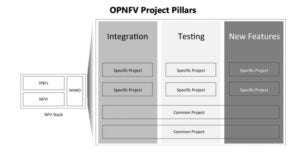This post first appeared on LinuxFoundation.org
By Amar Kapadia
The Understanding OPNFV book takes an in-depth look at network functions virtualization (NFV) and provides a comprehensive overview of The Linux Foundation’s OPNFV project. In this article, we provide some excerpts from the book and discuss some organizational elements required to make your NFV transformation successful. These best practices stress how both technical and non-technical elements are required, with non-technical often being more critical.
According to the project’s website:
Open Platform for NFV (OPNFV) facilitates the development and evolution of NFV components across various open source ecosystems. Through system level integration, deployment and testing, OPNFV creates a reference NFV platform to accelerate the transformation of enterprise and service provider networks.
As the demand for more robust and agile networks increases, organizations are looking to technologies such as NFV to bring the scale and flexibility of cloud architecture to networking. OPNFV is the only platform that builds and integrates elements — including functional support for Management and Orchestration (MANO) — across multiple end-to-end open networking stacks that meet the needs of end users to enable accelerated NFV.
What is OPNFV?
OPNFV is not a traditional software development project. Instead, OPNFV integrates a number of upstream projects and tests them. Of course, there is a software development component as well, but those contributions are to fill carrier-grade feature gaps in upstream projects. The project is organized around the following three pillars:

- Integration: OPNFV integrates a variety of open source projects to address specific NFV requirements.
- Testing: OPNFV tests the entire stack across a variety of NFV-specific parameters.
- New features: For each upstream open source project, OPNFV serves as the vehicle for NFV requirements. By actively working upstream and providing a single voice for NFV requirements, OPNFV steers these open source projects to better serve the needs of NFV.
OPNFV is an integration project whose work involves testing, CI/CD, documentation, and more. If you are looking to deploy NFV across telco or enterprise networks using open source projects, consideration of OPNFV isa wise first step that could save significant time and effort when setting up and running integrated testing of open source components.
How to Benefit from NFV
When starting your NFV transformation journey, there are both technology changes and organizational changes to consider. Here are three new technology changes that organizations need to embrace to get the full benefit of NFV:
- Model-driven architectures
- DevOps
- Cloud native virtual network functions (VNF)
Model-driven architectures convert manual infrastructure definitions and processes to code, allowing full automation of network service and VNF deployment, and subsequent day-2 monitoring and lifecycle management.

DevOps introduces continuous integration (CI), continuous testing, continuous deployment (CD), and continuous monitoring of VNFs.

Additionally, cloud native VNFs allow for faster development and the use of cloud architectures where reliable, scalable services can be built on powerful and economic, but sometimes unreliable industry standard hardware.
In this book, we also outline what organizational changes need to be put in place to effect the above three technology changes.
In planning your NFV transformation, you should consider the following best practices, based on the experience of other telecom operators. The concepts are explained in detail in the book.
- Clearly articulate goals.
- Build skills organically
- Agile instead of big bang
- Pace your journey
- Find use case
- Find executive sponsor
- Use dedicated teams
- Spread the knowledge
Why Consider OPNFV?
As you can see, NFV transformation is about process, organization structure, and skill set acquisition as much or more than it is about the technology. And, OPNFV is an unparalleled community with deep exposure to these aspects in addition to technology. OPNFV helps not only with technology, but also more broadly with the non-technical aspects of NFV transformation.
Intrigued? You can learn more in the previous blog that introduced NFV concepts, download the Understanding OPNFV ebook in PDF (in English or Chinese), or order a printed version on Amazon.
